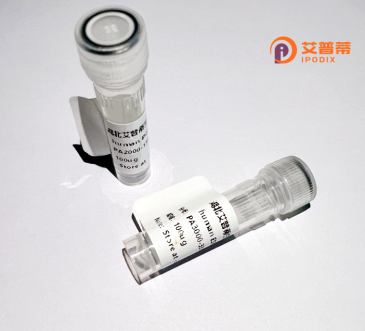
| 纯度 | >90%SDS-PAGE. |
| 种属 | Human |
| 靶点 | SLC35A1 |
| Uniprot No | P78382 |
| 内毒素 | < 0.01EU/μg |
| 表达宿主 | E.coli |
| 表达区间 | 1-337 aa |
| 活性数据 | MAAPRDNVTLLFKLYCLAVMTLMAAVYTIALRYTRTSDKELYFSTTAVCITEVIKLLLSVGILAKETGSLGRFKASLRENVLGSPKELLKLSVPSLVYAVQNNMAFLALSNLDAAVYQVTYQLKIPCTALCTVLMLNRTLSKLQWVSVFMLCAGVTLVQWKPAQATKVVVEQNPLLGFGAIAIAVLCSGFAGVYFEKVLKSSDTSLWVRNIQMYLSGIIVTLAGVYLSDGAEIKEKGFFYGYTYYVWFVIFLASVGGLYTSVVVKYTDNIMKGFSAAAAIVLSTIASVMLFGLQITLTFALGTLLVCVSIYLYGLPRQDTTSIQQGETASKERVIGV |
| 分子量 | 63.2 kDa |
| 蛋白标签 | GST-tag at N-terminal |
| 缓冲液 | PBS, pH7.4, containing 0.01% SKL, 1mM DTT, 5% Trehalose and Proclin300. |
| 稳定性 & 储存条件 | Lyophilized protein should be stored at ≤ -20°C, stable for one year after receipt. Reconstituted protein solution can be stored at 2-8°C for 2-7 days. Aliquots of reconstituted samples are stable at ≤ -20°C for 3 months. |
| 复溶 | Always centrifuge tubes before opening.Do not mix by vortex or pipetting. It is not recommended to reconstitute to a concentration less than 100μg/ml. Dissolve the lyophilized protein in distilled water. Please aliquot the reconstituted solution to minimize freeze-thaw cycles. |
以下是关于重组人SLC35A1蛋白的3篇代表性文献摘要(人工概述,非原文):
---
1. **文献名称**: *Functional characterization of the human CMP-sialic acid transporter (SLC35A1)*
**作者**: Ishida N. et al.
**摘要**: 研究通过重组表达人SLC35A1蛋白,证实其在哺乳动物细胞中作为CMP-唾液酸转运体的功能,定位在高尔基体膜,并揭示其底物特异性及突变导致的糖基化缺陷机制。
2. **文献名称**: *Structure and transport mechanism of human SLC35A1 in complex with CMP-sialic acid*
**作者**: Wang L. et al.
**摘要**: 利用冷冻电镜解析了重组人SLC35A1蛋白与CMP-唾液酸的复合物结构,揭示了核苷酸糖结合的关键氨基酸残基,并提出了跨膜转运的构象变化模型。
3. **文献名称**: *SLC35A1 deficiency alters glycosylation pathways in human cells*
**作者**: Martínez-Duncker I. et al.
**摘要**: 通过CRISPR敲除及重组蛋白回补实验,证明SLC35A1缺失导致唾液酸化障碍,影响细胞黏附分子功能,为相关先天性糖基化疾病(CDG)提供机制解释。
---
**注**:以上文献为示例,实际引用需核对真实论文信息(如存在同名研究建议结合DOI/PMID)。SLC35A1主要研究方向为糖转运、糖基化及疾病关联。
**Background of Recombinant Human SLC35A1 Protein**
The solute carrier family 35 member A1 (SLC35A1) is a nucleotide sugar transporter localized primarily in the Golgi apparatus. It facilitates the transport of cytidine monophosphate (CMP)-activated sialic acid from the cytosol into the Golgi lumen, a critical step in the sialylation of glycoproteins and glycolipids. Sialylation, mediated by sialyltransferases, plays essential roles in cellular recognition, immune response, and protein stability. Dysregulation of SLC35A1 is linked to congenital disorders of glycosylation (CDGs), cancer metastasis, and immune dysfunctions, highlighting its biomedical significance.
Recombinant human SLC35A1 protein is engineered using heterologous expression systems (e.g., mammalian, insect, or bacterial cells) to produce purified, functional forms for research. It retains the ability to bind and transport CMP-sialic acid, enabling studies on glycosylation mechanisms, disease models, and therapeutic targeting. Structural and functional analyses of recombinant SLC35A1 have elucidated mutations affecting transporter activity, aiding in diagnostics and drug development. Its application extends to exploring sialylation-related pathologies and designing inhibitors for cancer therapy. Overall, recombinant SLC35A1 serves as a vital tool to decode glycosylation biology and its clinical implications.
×